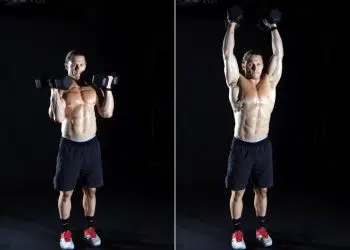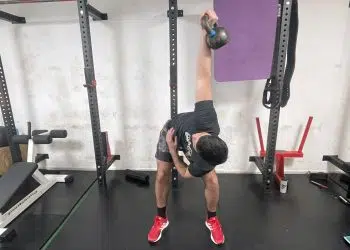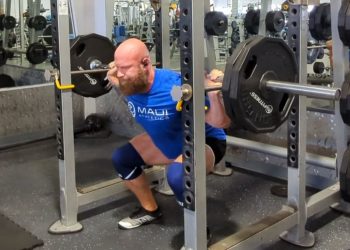Variation is the name of the game in weight training. Performing the same exercise every week can lead you to a plateau. It is easier to avoid an overhead ceiling than to break through one. Using exercise variations helps you train your muscles from different angles, which keeps your muscles guessing — and growing.
Things, however, get complicated when similar-looking exercises have different names — case in point — the military press, overhead press, shoulder press, and push press.
People might switch between these exercises in hopes of avoiding a plateau. Still, they are training the same muscle groups from the same angles, rendering these variations ineffective for avoiding a roadblock.
Most lifters are clueless about these shoulder exercises and use the terms military press, overhead press, shoulder press, and push press interchangeably. This, however, is a mistake.
Our lifting forefathers gave these exercises different names for a reason. Although the military, overhead, shoulder, and push press follow the same movement pattern, there are subtle differences between the four.
Learning about the differences can help you design better training programs for yourself or your clients. Nonetheless, it puts you in a position to give unsolicited advice to lifters in your gym.
Level Up Your Fitness: Join our 💪 strong community in Fitness Volt Newsletter. Get daily inspiration, expert-backed workouts, nutrition tips, the latest in strength sports, and the support you need to reach your goals. Subscribe for free!
This article explains the differences between the military, overhead, shoulder, and push press. We also cover the muscles worked, common mistakes people make while doing these pressing movements, and who each exercise is best suited for. There is a lot to cover, so sit tight.
Difference Between Military Press, Overhead Press, Shoulder Press, and Push Press
Overhead pressing exercises help build shoulder strength and muscle mass. It can also improve your shoulder mobility. The military, overhead, shoulder, and push press are compound (multi-joint) pressing movements, where your shoulders and arms are the primary movers.
Here is a brief overview of each exercise:
Military Press
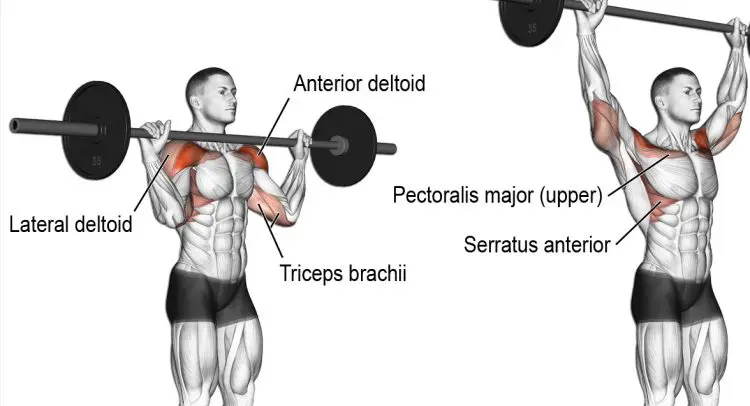
The military press is a strict standing barbell overhead pressing exercise, hence its name. It involves lifting the bar from shoulder height to lockout at the top. In this exercise, you must only use your shoulder strength to hoist the bar overhead and are barred from using your legs.
You must perform the military press while standing. Although you’ll see some fitness influencers do the ‘seated military press,’ it is a technically incorrect term. The seated military press is actually an overhead press.
Overhead Press

You can use a barbell, dumbbells, kettlebells, and resistance bands in the overhead press and perform the exercise while standing or seated. You are not bound to maintain a rigid lower body in the overhead press, as with the military press.
Using your lower body allows you to lift slightly heavier weights on the overhead press than the military press. You can, however, use momentum by jerking your knees only during the final reps of a set. Using your legs from the first rep reduces the muscle-building potential of the exercise by reducing the stress on your deltoids.
You must maintain a stable core and ensure you are not rounding your back to reduce the risk of injury.
Shoulder Press
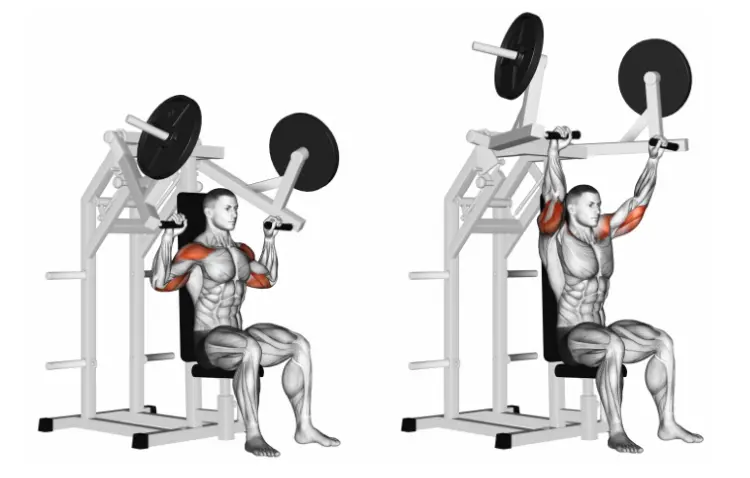
The shoulder press is a generic term used for any shoulder pressing exercise, including the military and overhead press. You can do the shoulder press while seated or standing using dumbbells, barbells, kettlebells, resistance bands, or a machine.
If you are confused between a military press and an overhead press, just call it a shoulder press and move on. No one can raise a finger at you for calling a military press a shoulder press.
Push Press
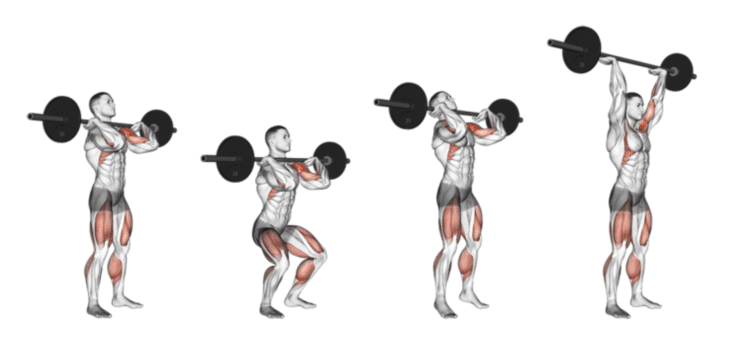
The push press is an underappreciated shoulder exercise that looks like its sibling vertical shoulder pressing movements but can help you lift a lot heavier. This exercise requires you to use momentum to lift the barbell overhead by bending your knees.
The push press is a standing shoulder press variation that can be done with dumbbells, barbells, kettlebells, or resistance bands. While performing this shoulder press variation, your focus is to lift the bar overhead as quickly as possible. This exercise can help build explosive strength in the upper body.
On the other hand, in the military and overhead press, you must control the eccentric (lowering) and concentric (upward) motion for optimal results. Your shoulders and triceps are your primary muscle groups in the military and overhead press.
And yes, the push press is also a shoulder press variation!
How To Do The Military Press, Overhead Press, Shoulder Press, and Push Press
Now that you know the basics of the four overhead pressing movements, below is how to perform each lift with the correct form. We’ll use different equipment and stances for each exercise to display the differences better.
Military Press
Your focus on the military press is to move the shoulders through their full range of motion while maintaining a strict stance.
Steps:
- Stand upright with a shoulder-wide stance.
- Grab a barbell at shoulder-width with a pronated (palms facing forward) grip.
- The bar should be in front of your shoulders at the starting position.
- While keeping your torso upright, press the bar overhead to lockout.
- Slowly return to the starting position by unlocking your elbows.
- The bar should touch your shoulders at the bottom.
- Repeat for recommended reps.
Pro Tip: The bar should be above your heels, and your ears should be between your arms at the movement’s top.
Overhead Press
We’ll be describing the seated dumbbell overhead press for this example.
Steps:
- Sit upright on one end of a flat bench.
- Grab a dumbbell in each hand with a neutral (palms facing each other) grip and place them on your quads.
- Kick up the dumbbells to your shoulder height and turn your wrists outward. The dumbbells should be next to your ears at the starting position.
- Brace your core and press the dumbbells overhead while maintaining a neutral spine.
- Stop the movement before elbow lockout, as it helps maintain constant tension on your deltoids.
- The dumbbells should be a few inches away from each other at the top.
- Slowly lower the dumbbell to the start position.
- Repeat for reps.
Pro Tip: Avoid keeping your elbows and shoulders in a straight line while performing the exercise, as it can unnecessarily stress your shoulder rotator cuffs.
Machine Shoulder Press
As you know by now, each shoulder overhead pressing exercise can be called a shoulder press. For this example, we’ll be illustrating the shoulder press machine.
Steps:
- Sit on a shoulder press machine.
- Adjust the handles or the seat so the handles are at your shoulder height.
- Grab the handles with a pronated or neutral grip.
- Brace your core and press the handles overhead.
- Stop before reaching full elbow extension.
- Slowly return to the start position.
- Repeat for recommended reps.
Pro Tip: The shoulder press machine handles follow a fixed trajectory, and some machines move at a slight angle, which can be great for beginners and folks dealing with injuries.
Push Press
The push press is a great exercise to build explosive upper-body strength. You must, however, master the overhead press before progressing to the push press. Performing this exercise with a solid foundation limits your odds of injury.
Steps:
- Stand upright with a shoulder-wide stance.
- Grab the bar with a shoulder-width pronated grip.
- Hold the bar in a front rack position.
- Brace your core and bend your knees slightly to create a few inches of leverage.
- Explode with your legs and hips and push the bar overhead with your shoulders to lockout.
- Slowly lower the weight to the start position.
- Repeat for reps.
Pro Tip: You need upper body mobility to hold the bar in a front rack position. Perform mobility drills before your workouts for optimal range of motion.
Muscles Worked in the Military Press, Overhead Press, Shoulder Press, and Push Press
Here are the common muscles worked with the four pressing movements explained in this article:
Shoulders
Deltoids are the primary target muscle groups of the overhead pressing movements; they consist of three heads — anterior, middle, and posterior. The military, overhead, push, and machine press works the anterior and middle delts.
Triceps
The triceps brachii (the horseshoe muscle at the back of your upper arm) is engaged while pressing the bar overhead. Tuck in your elbows to generate the maximum pushing force during these shoulder exercises.
Level Up Your Fitness: Join our 💪 strong community in Fitness Volt Newsletter. Get daily inspiration, expert-backed workouts, nutrition tips, the latest in strength sports, and the support you need to reach your goals. Subscribe for free!
Upper Chest
Your upper pectoral muscles are engaged in vertical pressing exercises. Many trainers can lift relatively heavy on seated shoulder presses on a utility bench as they perform the exercise by leaning back into the chair, helping them engage their upper pecs to a great extent.
Upper Back
Upper back muscles such as the trapezius and rhomboids help stabilize your body during the overhead pressing exercises. Notably, poor upper back mobility can restrict your overhead pressing performance.
Core
Contracting your core and glutes while performing the overhead pressing lifts helps stabilize your body. Your core plays a vital role in these exercises as you progress to bigger weights. Using a weightlifting belt while performing shoulder presses can reduce your risk of injury.
Legs (only in push press)
The push press involves using your legs to generate power and momentum. You’ll feel a pump in your quads, glutes, and calves while performing the push press. Using your legs will help you lift relatively heavier.
Common Mistakes While Performing the Military Press, Overhead Press, Shoulder Press, and Push Press
Most lifters commit the following errors while performing these overhead pressing movements:
Confusing the Exercises
The first common mistake people make with these exercises is misidentifying them. They also read too much into a lifter’s foot placement while performing these exercises. Your foot placement doesn’t define the exercise.
Many lifters assume that a shoulder press with a narrower-than-shoulder-width stance is a military press and a shoulder-width or broader is an overhead press. We hope you will not make this mistake again.
Incorrect Bar Path
In a standing shoulder press, most lifters press the barbell forward instead of pushing it directly overhead. The bar should be in line with your heels at lockout. Most lifters, however, have the bar over their toes. This position strains your lower back and puts you at risk of injury.
Push your head between your arms while getting into a lockout. Your ears should be between your upper arms. You must work on your upper back mobility and lower the weights if you have trouble locking out the bar overhead.
Head Position
The standing barbell shoulder press exercises are technically more complicated than the seated variations, as you need to move your head constantly throughout the range of motion. Your head should move backward as you push the bar upward from your shoulder level and then move forward as you complete the lift.
You’ll bang your head into the bar if you don’t move your head during the barbell shoulder presses. Practice the exercise with lighter weights before challenging yourself with bigger poundage.
Incorrect Grip and Wrist Position
You must hold the barbell or dumbbells slightly wider than shoulder-width in each of these exercises for optimal deltoid stimulation. Placing your hands too wide or narrow will strain your rotator cuffs.
Furthermore, you must keep your wrists tight and rigid while performing overhead presses. Letting your wrists bend backward excessively under heavy weight can hamper your performance.
Flared Elbows
Many lifters hold their elbows wide to their sides in hopes of better shoulder muscle fiber recruitment. Flaring your elbows too wide puts unnecessary strain on your shoulder rotator cuffs and hampers your pushing strength.
Keep your elbows tuck in and down while doing overhead pressing movements. It will help improve stability and generate more power for lockout at the top.
Overarching Your Back
Vertical pressing exercises compress the spine. Many lifters arch their back at the bottom of the lift to get under the bar. They straighten their back during the concentric movement to generate momentum and then arch their lower back arch at lockout because of poor upper back mobility.
Arching your back during overhead presses puts your lower back at risk of injury. You must maintain an upright torso throughout the exercise to work the target muscles optimally and reduce the risk of injury. Work on your upper back mobility and use lighter weights if you cannot stay upright during overhead pressing exercises.
Benefits of Military Press, Overhead Press, Shoulder Press, and Push Press — Who Should Use Which? When To Use Each?
The military, overhead, shoulder, and push press follow the same movement pattern but train your muscles differently and can have varying benefits and performance results.
For the scope of this section, we will club the military press, overhead press, and shoulder press into the shoulder press category and compare it with the lower-body engaging push press.
Below are the benefits of shoulder press and push press:
Muscle Hypertrophy
Research shows that staying in the 8-12 rep range is best for inducing hypertrophy. Although you could perform shoulder presses and push presses for the recommended reps, shoulder presses require you to follow a slow, controlled, and deliberate range of motion. In contrast, the push press involves powering through the reps. [1]
Performing controlled reps are more effective at achieving a mind-muscle connection and contracting target muscles with each rep. You must stick to the military press, overhead press, and shoulder press if your goal is to build muscle mass.
Strength
The push press involves lifting heavier weights as quickly as possible, while the shoulder press exercises require you to perform controlled eccentric and concentric movements. Push presses will drive you to lift heavier, whereas shoulder presses will promote stability and control. You should do both types of exercises to build strength.
Explosive Power
Olympic and strongman lifts require you to move the most weight through the full range of movement as quickly as possible. The leg drive in the power press makes it the perfect lift for building explosive strength.
Athletic Performance
Athletes like football and basketball players require agility, explosive strength, and endurance. Shoulder press exercises work only your upper body, whereas the push press works your entire body. The push press is a better exercise for athletes.
Weightlifters, strongmen, and athletes are better off doing the push press as it helps build explosive strength. On the other hand, bodybuilders looking to gain muscle mass should prefer the shoulder presses.
Notably, the push press is an advanced shoulder press exercise. You must master the military press, overhead press, and shoulder press fundamentals before moving on to the push press.
Frequently Asked Questions
Which exercise among military, overhead, shoulder, and push press is better for building explosive strength?
If your goal is to build explosive power, choose the push press, as the leg drive in this exercise allows you to lift heavier weights. You must, however, cycle between the four exercises to train your shoulders from different angles and add variety to your training regimen.
Is the military press harder than the push press?
The military press requires brute upper body strength, whereas the push press demands upper and lower body coordination to move heavy weights. The answer to this question will depend on personal strengths. Your military press will be stronger if you have more muscular shoulders and have never trained the push press.
Wrapping Up
The military, overhead, shoulder, and push press are vertical press variations with subtle differences in technique, targeted muscles, and variations. The military press is done with a barbell, whereas you can do the other three exercises with dumbbells, resistance bands, kettlebells, and machines.
When choosing between these exercises, you must consider your goals, fitness level, and physical limitations. The military, overhead, and machine shoulder press require a controlled range of motion, which makes it a better fit for bodybuilders training for hypertrophy. The push press is a better alternative for weightlifters, strongmen, and CrossFitters that want to build explosive strength. Finally, incorporating all four exercises into your training regimen will add variety to your training regimen and will make you an all-round strength sports athlete.
References
- Krzysztofik M, Wilk M, Wojdała G, Gołaś A. Maximizing Muscle Hypertrophy: A Systematic Review of Advanced Resistance Training Techniques and Methods. Int J Environ Res Public Health. 2019 Dec 4;16(24):4897. doi: 10.3390/ijerph16244897. PMID: 31817252; PMCID: PMC6950543.
Interested in measuring your progress? Check out our strength standards for Push Press, Machine Shoulder Press, Seated Shoulder Press, and more.



